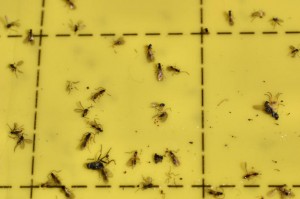
Almost all greenhouse growers find themselves battling little black flying insects in their greenhouses at some point in their careers. Small black flying gnats can be shore flies (Ephydridae family) or fungus gnats (Sciaridae or Mycetophilidae families).
The shore flies are commonly found in greenhouses or nurseries where algae is growing on the soil surface or floor. They feed on algae and although they are a nuisance, they pose no threat to plants. Their larvae look like maggots and are wedge shaped. The adults look more like the common housefly flies with short bodies and small antennae.
Fungus gnats have long, thin bodies and pose a greater problem to greenhouse crops. While the adults are primarily an annoyance, the larvae can feed on plant roots as well as fungus and organic matter. The larvae are clear and worm-like with a black head. No potting mixes have been found to be immune from fungus gnats.
A greenhouse grower can prevent infestation by reducing excess moisture and algae in their greenhouse. Here are some specific tips towards reducing fungus gnat populations:
- Use hydrated lime on greenhouse floors to reduce algae growth. This creates a less inviting environment for fungus gnats.
- Yellow sticky traps help to trap and monitor pest populations.
- Keep the tops of pots as dry as possible; water from the bottom. This prevents the adults from laying eggs on the surface. An adult’s life span is approximately 7 days.
- If you notice little, gray-brown mites on the surface of the mix, rejoice. These are predatory mites who eat fungus gnats; they will die off when they run out of food.
There are many products available that have been used to effectively control fungus gnats and shore flies. These include insect growth regulators and beneficial insects that help control larvae, as well as
conventional insecticides that kill adults on contact. Here are some of the most common of these controls:
Biological controls:
- Insect-attacking nematodes (mostly Steinernema feltiae)
- Predatory mites in the genus Hypoaspis
- Bacillus thuringiensis H-14
- (Gnatrol)
- Diatomaceous Earth (incorporated or applied to surface of media)
Insect Growth Regulators (IGR’s) that prohibit pests from reaching adulthood and thus the reproductive stage:
- Azatin (Azadirachtin)
- Citation (Cyromazine)
- Precision (Fenoxycarb)
- Enstar II (Kinoprene)
- Adept (Diflubenzuron)
Conventional insecticides:
- DuraGuard (Chlorpyrifos)
- KnoxOut GH (Diazinon)
~Michelle Miller and Nancy Morgan
